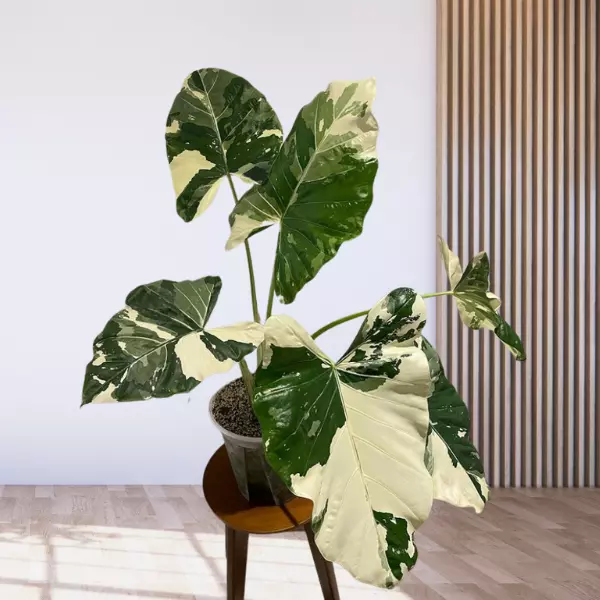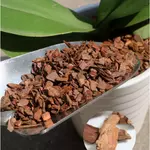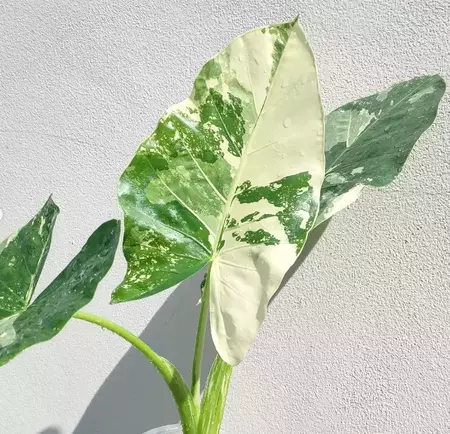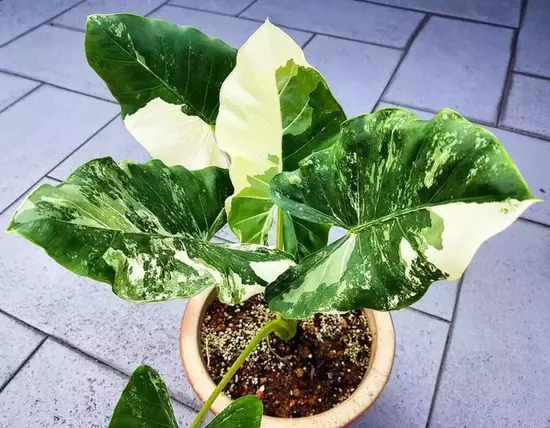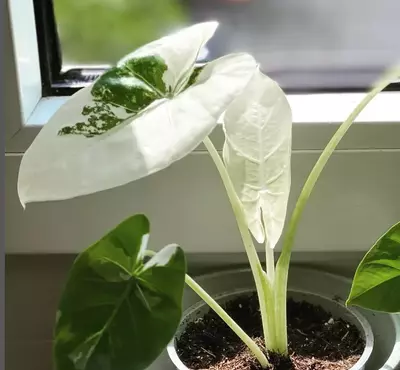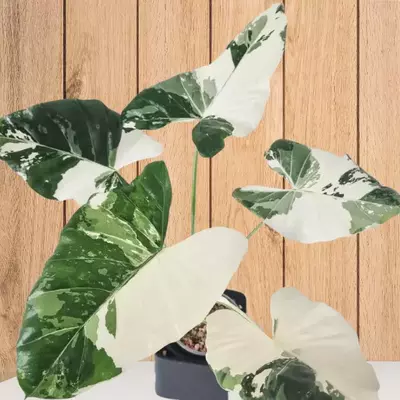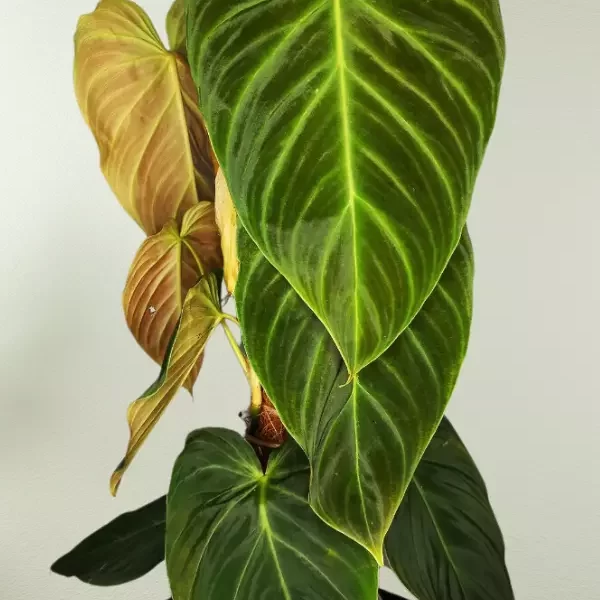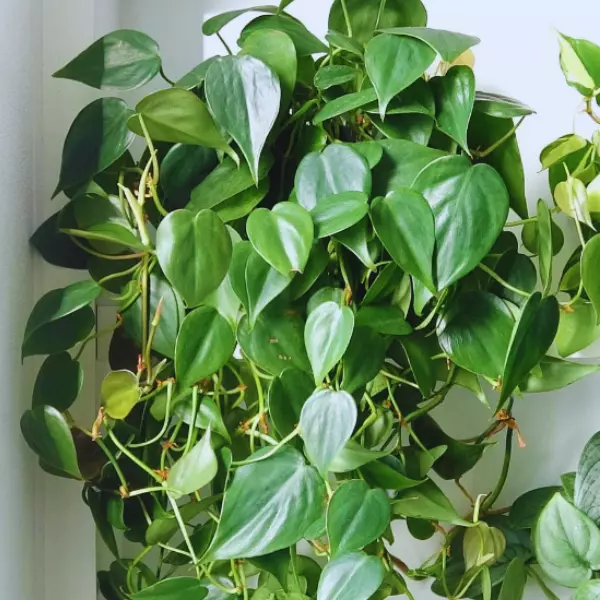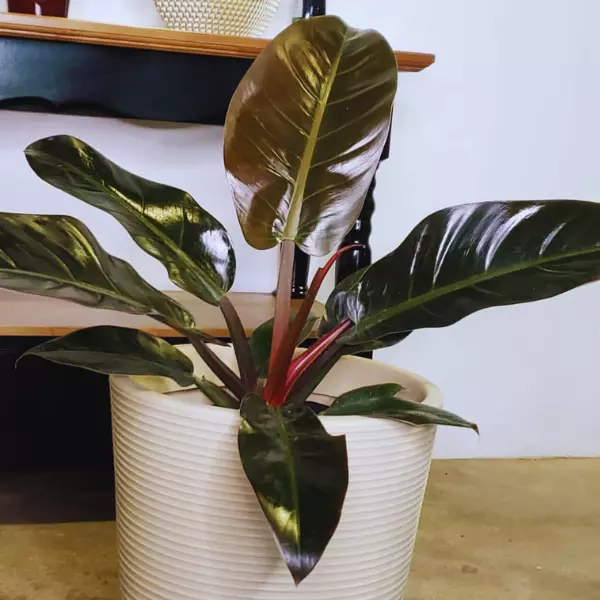Alocasia Macrorrhiza Variegata is a striking beauty exhibiting gigantic, variegated foliage marbled with tones of light green and white blotches. Macrorrhiza Variegata is a herbaceous and evergreen beauty, highly popular in interior design for homes, indoors and outdoors. Moreover, its vast spread and tropical vibes create a well-balanced peaceful ambience of styles in spaces like patios, hotels, offices, and lobbies. An aesthetically intriguing work of art by nature that stands out in plant collections due to its eye-catching charming beauty. The Macrorrhiza Variegata’s foliage resembles the elephant’s ear because of its enormous foliage.
Allied Species: Alocasia Sarian, Alocasia Pink Dragon, Alocasia Lauterbachiana, Alocasia Silver Dragon, Alocasia Stingray, Alocasia Regal Shields, Alocasia Nebula, Alocasia Maharani, Alocasia Jacklyn , Alocasia Cuprea, Alocasia Black Velvet , Alocasia Macrorrhiza
Related Products
Products | Name | Check Price |
Organic Perlite for Plants | ||
WONDER SOIL Organic | ||
Orchid Potting Bark Mulch |
Habitat & Ecology
Alocasia Macrorrhiza Variegata is endemic to the rainforests of Malaysia, Maritime Southeast Asia, New Guinea, and Queensland. In addition, it has also been cultivated in the Philippines and numerous Pacific islands for decorative purposes. It is commonly known as Variegated Elephant Ear or Elephant ear Plant.
| Botanical Name: | Alocasia Macrorrhiza Variegata |
| Family Name: | Araceae |
| Common names: | Elephant Ear, Variegated Elephant Ear |
| Origin | South pacific |
| Height | 12–15 feet |
| Spread | 6–10 feet |
| Humidity | 60-80% |
| Light Need | Bright, indirect light |
| Watering | when top half of the soil is dry |
| Soil Type | Loam (Silt), quick-draining |
| Planting Time | Spring / Summer |
| Flower Inflorescence | Green spathe and white Spadix |
| Zones | USDA 10 & 11 |
What is Alocasia Macrorrhiza Variegata?
Alocasia Macrorrhiza Variegata, also called Elephant’s Ear, is a member of the Araceae family and is a variant of Alocasia Macrorrhiza. This stunning variegated plant is grown and collected for its exotic variegated foliage. The unique foliage features upright blade-shaped leaves with distinct veins and ruffled, white margined edges emerging from rigid variegated stalks called long-sheathed petioles.
In ideal growing conditions, this evergreen plant can reach heights of up to 12–15 feet and a spread of 6–10 feet. Its size and glossy variegation on the leaves are this plant’s main highlights, making it a highly demanded plant for indoor collections and outdoor landscaping in recent years. Many gardeners enjoy including this plant to create a tropical atmosphere.
Alocasia Macrorrhiza Variegata produces inflorescence in a green colour spathe and white spadix that turns to pale yellow over time which later develops into red fruits and set seeds. The plant produces these fragrant blooms when it matures, and it takes years for the plant to reach its maturity.
How do you take care of Variegated Alocasia Macrorrhiza?
Variegated Alocasia Macrorrhiza is a relatively low-maintenance rare houseplant that thrives in a well-draining, moist, and organic soil mix. This Elephant ear plant prefers a warm and humid environment in abundant sunlight (not direct sunlight). It can be grown outside in the partial shade, receiving morning or evening sunlight.

Initial Care at Home
When bringing your Alocasia Macrorrhiza Variegata home, inspect your plant thoroughly for any pests and diseases. You might want to shower your plant to eliminate any dust and pests. We recommend quarantining your plant before introducing it to other plants. Alocasias are generally Spider mites magnets and may come infested with fungal Gnats and Spider mites. Treat your plant if infested before you put it with your other plants.

Water needs of Alocasia Macrorrhiza Variegata
Alocasia Macrorrhiza Variegata loves moisture; this water-loving plant needs plenty of water all year, especially in summer. When it comes to watering, please wait for the topsoil layer to dry before watering it again. We recommend watering when the substrate is about half dry to 2/3, NOT completely dry. Make sure the water is distributed evenly while watering. Please keep the soil moist, not soggy, to prevent several diseases like root rot caused by overwatering.
The frequency of watering depends on the type of substrate and climate. It is recommended to water this Elephant ear plant once a week, usually depending on the dryness of the soil. When you water, drench the soil and let the excess water drain completely.
We recommend using distilled water for Alocasia Macrorrhiza Variegata. But if you water your plant with tap water, I advise you to keep it for 24 hours before watering to prevent soil from clogging with chemicals and minerals, harming the plant’s health.
Overwatering: Overwatering will result in moldy soil, a greater risk of root rot, and yellowing leaves. It would result in the plant’s health deterioration and eventually can cause death if the plant is left untreated.
Underwatering: Inadequate water is not as worse as Overwatering. But it is not like it doesn’t impact your plant’s well-being. Plant growth will slow down, and leaves will droop and turn brown and yellow due to an insufficient water supply.

Sunlight Requirement
The partial sun or shade is ideal for the Alocasia Macrorrhiza to grow. Its gigantic leaves are susceptible to scorching under intense direct sunlight. Bright yet indirect lighting is required for this Elephant Ear plant. It can be exposed to direct morning or evening sunlight for a couple of hours daily. The sun will be less harsh in the morning, so placing it outside for a few hours will be beneficial.
If you have placed it indoors, choose a spot such as an east or north-facing window where it can get indirect bright light. For outdoors, choose a sheltered or shady spot to save its beautiful leaves from direct sunlight and strong winds.
Similarly, Alocasia Macrorrhiza Variegata plants can tolerate low light but will not thrive in low-light circumstances. Its enormous, exquisite leaves may turn yellow in too dark areas. Additionally, it will slow down its growth and raise the possibility of root rot as the plant won’t be able to photosynthesize appropriately and consume all the water. You can also install grow lights to provide an even distribution of light if you don’t have bright spots at your place.
The light requirement of Variegated Alocasia Macrorrhiza is between 10,000 to 20,000 lux. The variegated leaves of Macrorrhiza Variegata may need a brighter light for a more extended period during the day because the white variegated portions of leaves don’t have chlorophyll and will not photosynthesize to produce energy. Therefore, the green leaves may need to work longer to produce the energy for the plant to thrive.

Humidity and Temperature
Alocasias are tropical plants that prefer warm and humid climates to grow. Please ensure to provide a high humidity level for your indoor Alocasia Macrorrhiza Variegata to thrive more effectively. The ideal humidity for this Alocasia is at least 60%. It is not difficult to maintain if you live in a tropical country; however, the typical household environment has less than 50% humidity in other places.
There are a few ways to increase the humidity of the environment by mimicking its natural habitat; For example, you can place a pebble tray filled with water under the pot. It will increase the humidity level; as the water evaporates from the tray, the moisture level of its surroundings increases. You can use a plant humidifier or mist the Elephant’s Ear leaves more frequently to avoid dryness. Grouping this tropical plant with other plants can also help achieve the required humidity.
Ideal Temperature
Warm temperature is one of the essential factors for Alocasia Macrorrhiza Variegata to thrive. The ideal temperature for this tropical plant is between 65F° to 80°F (18 to 27ºC). A drop in temperature below 50 F° will result in stunted growth.
Cold and chilled environments severely affect the plant’s growth and health. Similarly, the hot temperature can also be disastrous for Alocasia Macrorrhiza Variegata, causing the browning of leaves. Alocasia macrorrhiza Variegata can be grown in areas within USDA hardiness zones 9b to 12. Finding a suitable location with a constant warm temperature is usually preferable. Please avoid placing this plant in spots with draughty windows, heaters and air conditioners.
There are some tips you can follow to avoid the impact of fluctuating temperatures on this beautiful plant’s leaves.
- Bring it indoors or somewhere warmer when it gets below 55 degrees.
- Keep it out of strong gusts so they don’t damage its big leaves.
- Avoid exposure to direct sunlight since it may burn the leaves and raise the likelihood of dehydration.

Soil Requirements:
As we mentioned earlier, Alocasias love moist but well-draining soil to thrive. So, a properly structured and well-drained soil mix is better to let the excess water drain and hold just the right amount of water. You can use any good aroid potting mix from the market or make it at home by combining the following components;
- 25% of orchid bark,
- 25% of coir,
- 25% of perlite,
- 10% of activated charcoal
- 10% of worm castings.
Mixing these components produces a porous, well-aerated soil mix with appropriate drainage. Roots of the plant love to breathe as much as we do; bark chips will help the oxygen to travel through the plant. It also encourages the plant to grow, especially its roots. If you have the chunkier mixture, your plant will likely adapt and grow thicker and strong roots.
Activated charcoal is another essential component as it can act as the soil’s filter. It will filter out all the impurities in the soil, eventually maintaining the PH level for Alocasia Macrorrhiza Variegata. The PH level must be both acidic and neutral (5.7 to 6.3).
Besides that, you can also choose various potting mixes available in the market such as:

Repotting:
Like humans, plants need food to grow and flourish. Most of the nutrients that plants need are provided by the medium in which they are grown. Gradually, these nutrients will deplete with time, leaving less rich soil than before. Repotting will improve the health of your indoor plants by giving them access to fresh, nutrient-rich soil and more space to grow.
Repotting is done mostly when the plant becomes root bound and can no longer grow. Usually, the roots come out of the drainage hole and grow circular around the root ball when there is no space left inside the pot. You can solve this issue by simply repotting your plant into a pot at least one size bigger than the current pot.
Step-by-step guide for repotting:

Propagation of Alocasia Macrorrhiza Variegata
There are many methods to multiply and propagate Alocasia Macrorrhiza Variegata plants, such as through corms, basal offset and tuber division. However, the basal division is the most efficient, successful and standard propagation method of Alocasia Macrorrhiza Variegata.
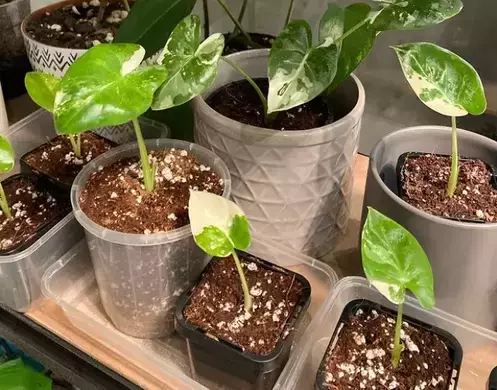
Propagation through Basal Offset Division:
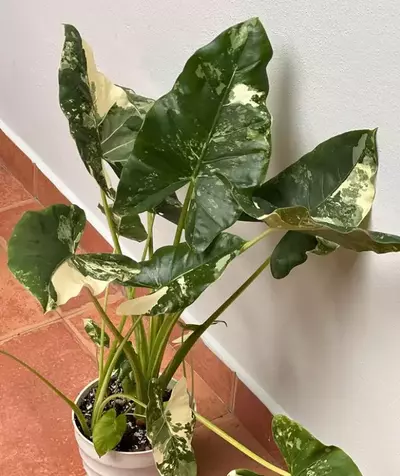
We suggest that if you have an albino baby as an offset of your Alocasia Variegata, do not cut it off from the mother because albinos on their own won’t survive. Albinos don’t have chlorophyll, so they cannot make food or cannot make their sugars to survive. Please keep the albino attached to the mother forever so that the mother can continue to feed the albino kid.
Propagation through Corms
Alocasia Macrorrhiza Variegata plants develop corms attached to their roots that can be used to produce new Alocasia plants. You can dig around the potting soil of your Alocasia plant and inspect the roots to find the corms. Gently detached the corms from the roots of the plant. However, you will be most successful in finding the corms during repotting.
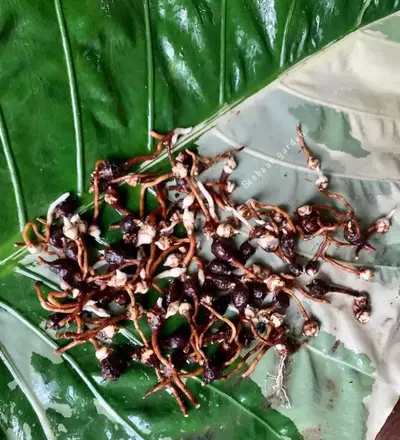
Later you can plant these corms in a moist soil medium, sphagnum moss or LECA and cover them to provide the required humidity. Moreover, you can also use a shallow puddle method to root the corms. Within a couple of weeks, you will notice growth from the corms. Once it has established enough roots and grows a few leaves, you can plant them in separate containers.
Propagation through Tuber Division
Alocasia Macrorrhiza Variegata is a tuberous plant and can be propagated through tuber division. The plant should have a long tuber with multiple growth points to propagate through tuber cutting. You don’t necessarily need to remove the plant from the pot for tuber cutting. Choose a point on the tuber where you want to cut your plant. Please include part of the tuber with multiple growth points and enough roots. Moreover, leave at least a quarter part of the tuber of the mother plant in the pot.
Take a sharp knife or cutter and cut the tuber horizontally. Gently pull out the roots of the newly cut tuber from the potting mix in the original pot. You can apply antifungal powder to freshly cut tuber parts to avoid rotting. You can plant the newly cut tuber in a separate container. Water the plant and place it in a warm, humid place to continue growing.
Within a few weeks, the mother plant tuber will shoot new growth and multiple offsets growing from the growth points of the main tuber. Once the offsets have established enough root systems, you can divide them from the mother plant.

Fertilizer
Like every other Alocasia, Variegated Macrorrhiza Alocasia also needs some fertilizers to flourish and grow to its full potential. It is a heavy feeder as compared to other Alocasias. You need to feed the Macrorrhizo Variegata with balanced diluted fertilizer (diluted to half the recommended strength) once every two weeks in the growing season-the Summer and Spring.
You can also feed the Osmocote slow-release fertilizer for nutrients. During Winter, the plant becomes dormant, therefore cutting back on feeding. Please remember to water the plant thoroughly before fertilization to ensure the even distribution of nutrients to the roots.
Overfertilization can cause salts to build up in the soil, resulting in the burning of roots and foliage. Just be careful not to overfertilize these delicate Alocasia plants.

Maintenance and Pruning
Maintenance of this Alocasia Macrorrhiza Variegata is not complex once you have learned what conditions are best for it. Provide your plant with the right amount of water, sunlight, humidity, and temperature. Remove yellow or decaying leaves and any plant detritus to promote healthier growing conditions.
Always use clean, sterilized shears or tools when pruning to lower the risk of bacterial and fungal infections. Never cut through yellowed tissue, as this could lead to severe harm from bacterial infections or other disorders. Always create clean incisions to avoid shocking the plant, resulting in decreased growth and a decline in health.
Moreover, wiping the leaves of Macrorrhizo Variegata with a damp cloth helps eliminate any dust and potential pests. It will prevent the pores from clogging with dust and help plants photosynthesize efficiently.

Toxicity
The leaves of this plant contain calcium oxalates, which are hazardous to humans and animals. If parts of this plant are eaten raw, it can cause digestive, throat, mouth, and even breathing issues like vomiting, loss of appetite, and nausea. The sap of Alocasia Macrorrhiza Variegata can cause skin irritation; therefore, we recommend using gloves while repotting and propagating. If ingested by pests, it can cause excessive drooling or wheezing. It is advised to keep it away from pests and kids.
Alocasia Macrorrhiza Variegata Vs. Alocasia Gageana Variegata

Alocasia Macrorrhiza Variegata and Alocasia Gageana are commonly confused, and you may find people having difficulty differentiating the two, which is understandable due to their highly similar variegated foliage. However, you can tell them apart by their leaf sinus. The Alocasia Macrorrhiza Variegata features an open leaf sinus, while the Alocasia Gageana has a closed leaf sinus. A leaf sinus is a space between where the petiole connects to the leaf and the lobes.
For Alocasia Gageana, there is an inch+ of the leaf between the middle dot and the opening of the leaf. Whereas for Alocasia Macrorrhiza Variegata, there would be less than a quarter of an inch.

Pests, diseases & common problems
Common problems of Alocasia Macrorrhiza Variegata:
There are some common issues that your Alocasia Macrorrhiza Variegata may suffer. We have addressed some of them in this article, so keep reading it till the end.
Drooping Leaves:
Alocasia Macrorrhiza Variegata’s enormous, drooping leaves can be extremely depressing to see. Too little or too much light exposure to the plant is the primary factor in this. Please put your plant in a spot with bright indirect light.
Mold Growth:
Once again, another issue caused by insufficient watering and too much exposure to heat and light lead to mold growth. To treat the problem, repot the plant in new soil and relocate it into some shade.
Yellowing and dying leaves
If your Alocasia Macrorrhiza Variegata leaves start turning yellow and dying, providing the optimum conditions, you don’t need to panic. Sometimes plant leaves turn yellow because the mother plant tries to conserve energy and food so that it can grow new babies that offset. If this happens, place your plant in medium light and water it even more sparsely. Hopefully, the plant will shoot some new growth.
Guttation (Dripping Water from leaves)
Alocasia Macrorrhiza Variegata may drip water from its leaves, indicating it is slightly overwatered and tries to get rid of the excess water by sweating it off. You might notice water droplets at the tip of the leaves, which may result in the browning of the tips. You can wipe off the water droplets. It is usual with Alocasias and nothing to panic about.
Pests and Diseases:
Your Alocasia Macrorrhiza Variegata isn’t pest-prone; it might run into some bugs. The most common predators of these Elephant plants are thrips, mealybugs, spider mites, Fungal Gnats, etc.
Spider Mites:
Leaves of Alocasia Macrorrhiza Variegata start to fall off because of spider mites. These pests also darken the leaves and cause streaks and dots on the leaves. It is challenging to spot spider mites with naked eyes, but their delicate webs underside of the leaves make them easy to identify. Neem oil or insecticidal soap can be applied to eliminate them effectively. Spider mites love a dry environment; please keep the humidity high around the plant.
You can spray a mixture of Neem oil, dishwashing soap and water. Thoroughly spray the mixture on the leaves and underside of the leaves.
Thrips:
Thrips are tiny, winged insects that can fly. They frequently produce white patches on the leaves and petals, and their excretion leaves tiny black marks on the leaves. Thrips are usually challenging to control. Use a combination of neem oil, insecticidal soap, and sticky traps to get rid of them.
Mealybugs:
Small nectar-sucking insects known as mealybugs can do a lot of harm to your Macrorrhizos. Constant use of neem oil and insecticidal soap can help eliminate these bugs.
Rust:
Rust is a fungal disease that won’t kill your Alocasia but will destroy the attractive appearance of the leaves. There are two common symptoms of rust.
- Brown spots on the lower side of the leaves.
- Large fade patches on the upper side of the leaves.
Remove the rust-infected leaves to save your plant from the further fungal spread. When humidity and warmth exceed, it can cause the growth of rust. Try to treat this disease as soon as possible because rust can travel in tissues, and it can damage the roots of your plant.
We recommend stop misting the plant and keep the plant leaves dry by putting the plant in place with enough airflow.
Fungal leaf blight:
Fungal leaf blight disease can produce lesions on the leaves that release fluids. If this disease is not treated as soon as it happens, it may cause the plant to wilt and eventually die. Early detection is key to combating fungal leaf blight. Spray the infected area with a copper-based fungicide every other week.
Frequently Asked Questions:
Q. How will I be able to tell if my Elephant’s Ear plant is underwatered?
Yellow leaves, brown leaf margins, and stunted development are typical signs of a houseplant suffering from the underwater issue.
Q. Does Alocasia Macrorrhiza Variegata needs fertilizers in fall and Winter?
The answer is No because it usually becomes dormant at the beginning of fall and throughout the winters, so it does not actively develop throughout these two seasons. Therefore, I advise against feeding during the fall and winter months.
Q. How much cold does Alocasia macrorrhiza Variegata can tolerate?
This species of AlocasiaAlocasia may survive in temperatures as low as ten °C (50°F). Your giant taro may be at risk of dying if the temperature drops.
Q. Is Alocasia Macrorrhiza Variegata rare?
Alocasia Macrorrhiza Variegata is a rare tropical plant grown and collected for its exotic, variegated foliage.
Final Words
Alocasia Macrorrhiza Variegata is a gigantic plant with striking foliage that makes it an attractive indoor plant. It is a subtropical species that is low maintenance for plant lovers. Alocasia Macrorrhiza Variegata is known for its beautiful leaf that can grow anywhere. It can be the perfect centrepiece for a tropical garden and indoor plant collections.
I hope this ultimate care guide will help you grow your Alocasia Macrorrhiza Variegata at home.
Happy Gardening!!
Related Posts
Philodendron Melanochrysum Care & Growing Guide
Philodendron ‘Splendid’ is a stunning hybrid of two stunning species of the Araceae family: Philodendron Melanochrysum and Verrucosum.
Philodendron Burle Marx Care & Propagation Guide
The most notable feature of the Philodendron Burle Marx is its large, glossy leaves, which come in heart-shaped or arrow-shaped variations.
Philodendron Scandens-“Sweetheart Plant” Easy Care Tips
Philodendron Scandens, often called the “Heartleaf Philodendron” or the “Sweetheart Plant” is a classic and most loved trailing houseplant.
Philodendron Erubescens ‘Imperial Red’ Care Tips
The Imperial Red Philodendron is easy to grow and can thrive well with little care and attention. Botanically known as Philodendron Erubescens.
Philodendron Ring of Fire Care & Growing Tips
Philodendron Ring of Fire is a striking plant known for its vibrant foliage and is believed a hybrid of Philodendron Wendlandii and P.Tortum.

